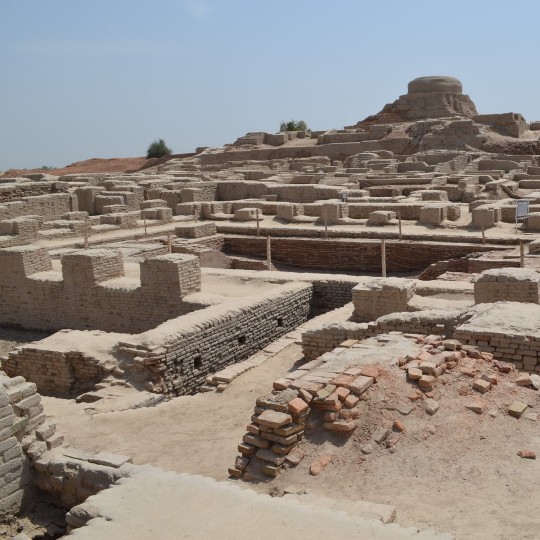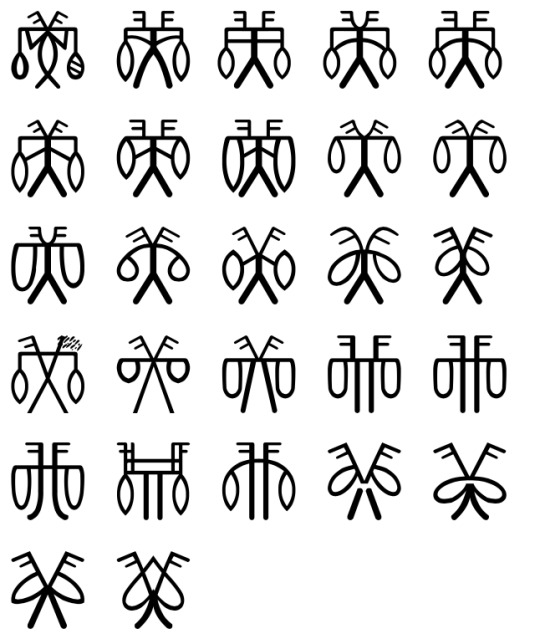#IndusScript
Explore tagged Tumblr posts
Photo

The Indus Valley Civilization was a cultural and political entity which flourished in the northern region of the Indian subcontinent between c. 7000 - c. 600 BCE. Its modern name derives from its location in the valley of the Indus River, but it is also commonly referred to as the Indus-Sarasvati Civilization and the Harrapan Civilization. These latter designations come from the Sarasvati River mentioned in Vedic sources, which flowed adjacent to the Indus River, and the ancient city of Harappa in the region, the first one found in the modern era. None of these names derive from any ancient texts because, although scholars generally believe the people of this civilization developed a writing system (known as Indus Script or Harappan Script) it has not yet been deciphered. All three designations are modern constructs, and nothing is definitively known of the origin, development, decline, and fall of the civilization. Even so, modern archaeology has established a probable chronology and periodization: Pre-Harappan – c. 7000 - c. 5500 BCE Early Harappan – c. 5500 - 2800 BCE Mature Harappan – c. 2800 - c. 1900 BCE Late Harappan – c. 1900 - c. 1500 BCE Post Harappan – c. 1500 - c. 600 BCE The Indus Valley Civilization is now often compared with the far more famous cultures of Egypt and Mesopotamia, but this is a fairly recent development. The discovery of Harappa in 1829 CE was the first indication that any such civilization existed in India, and by that time, Egyptian hieroglyphics had been deciphered, Egyptian and Mesopotamian sites excavated, and cuneiform would soon be translated by the scholar George Smith (l. 1840-1876 CE). Archaeological excavations of the Indus Valley Civilization, therefore, had a significantly late start comparatively, and it is now thought that many of the accomplishments and “firsts” attributed to Egypt and Mesopotamia may actually belong to the people of the Indus Valley Civilization. The two best-known excavated cities of this culture are Harappa and Mohenjo-daro (located in modern-day Pakistan), both of which are thought to have once had populations of between 40,000-50,000 people, which is stunning when one realizes that most ancient cities had on average 10,000 people living in them. The total population of the civilization is thought to have been upward of 5 million, and its territory stretched over 900 miles (1,500 km) along the banks of the Indus River and then in all directions outward. Indus Valley Civilization sites have been found near the border of Nepal, in Afghanistan, on the coasts of India, and around Delhi, to name only a few locations. Between c. 1900 - c. 1500 BCE, the civilization began to decline for unknown reasons. In the early 20th century CE, this was thought to have been caused by an invasion of light-skinned peoples from the north known as Aryans who conquered a dark-skinned people defined by Western scholars as Dravidians. This claim, known as the Aryan Invasion Theory, has been discredited. The Aryans – whose ethnicity is associated with the Iranian Persians – are now believed to have migrated to the region peacefully and blended their culture with that of the indigenous people while the term Dravidian is understood now to refer to anyone, of any ethnicity, who speaks one of the Dravidian languages. Why the Indus Valley Civilization declined and fell is unknown, but scholars believe it may have had to do with climate change, the drying up of the Sarasvati River, an alteration in the path of the monsoon which watered crops, overpopulation of the cities, a decline in trade with Egypt and Mesopotamia, or a combination of any of the above. In the present day, excavations continue at many of the sites found thus far and some future find may provide more information on the history and decline of the culture.
151 notes
·
View notes
Text

Variations of 'sign 4'; such variation makes distinguishing signs from allographical variants difficult, and scholars have proposed different ways to classify elements of the Indus script. Mahadevan, Iravatham (1977). The Indus Script: Text, Concordance And Tables. New Delhi: Archaeological Survey of India. https://upload.wikimedia.org/wikipedia/commons/0/0a/Indus_script_sign_4.png
0 notes
Photo

Ancient Secrets
Imagine an ancient civilization that rivaled Egypt and Mesopotamia in sophistication but remains a mystery to this day. The Indus Valley Civilization was a fascinating culture that thrived between 7000 and 600 BCE in the Indian subcontinent. Its cities like Harappa and Mohenjo-Daro hosted large populations, suggesting a highly developed urban society. Yet, despite its impressive accomplishments, the civilization's writing system remains undeciphered, leaving many secrets untold.
Introduction
The Indus Valley Civilization, spanning over 900 miles, was a cultural and political powerhouse. Its cities were significantly larger than most ancient urban centers, with populations reaching between 40,000 to 50,000 people.
Key Facts
Periodization:
Pre-Harappan (c. 7000 - 5500 BCE)
Early Harappan (c. 5500 - 2800 BCE)
Mature Harappan (c. 2800 - 1900 BCE)
Late Harappan (c. 1900 - 1500 BCE)
Post Harappan (c. 1500 - 600 BCE)
Located in the Indian subcontinent, with sites found as far as Afghanistan and Nepal.
Cities: Harappa and Mohenjo-Daro were major urban centers.
Population: Estimated 5 million people.
The Indus Valley Script remains undeciphered.
Historical Context
The Indus Valley Civilization was discovered relatively late compared to others like Egypt and Mesopotamia. This delayed discovery has led to the realization that some historical "firsts" attributed to these civilizations might actually belong to the Indus Valley people.
Historical Significance
The civilization's sophisticated urban planning and large population sizes highlight its advanced societal structure. The civilization's achievements suggest that it may have been a pioneer in various aspects of ancient culture.
Why You Should Know About It Today
Understanding the Indus Valley Civilization provides insights into the early development of human societies and challenges common historical narratives about the origins of civilization. Its mysterious script continues to fascinate scholars and the public alike, promising new discoveries in the future.
60 notes
·
View notes